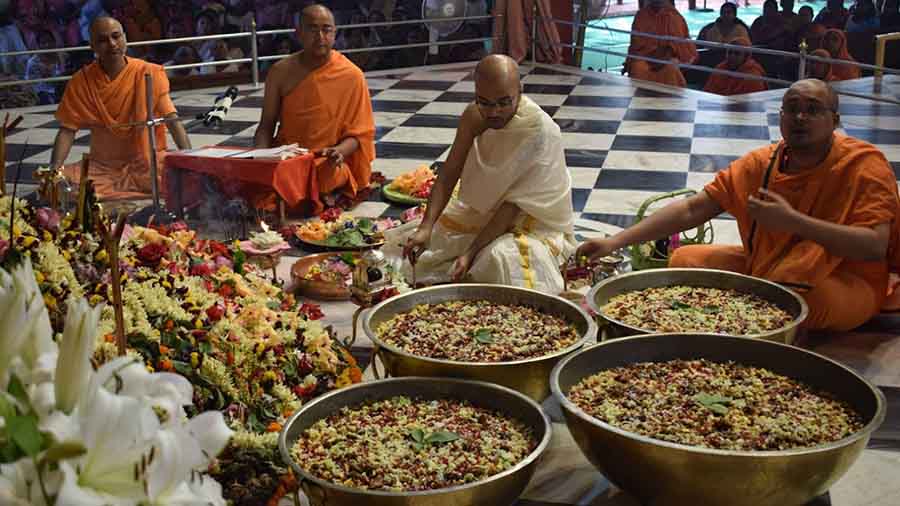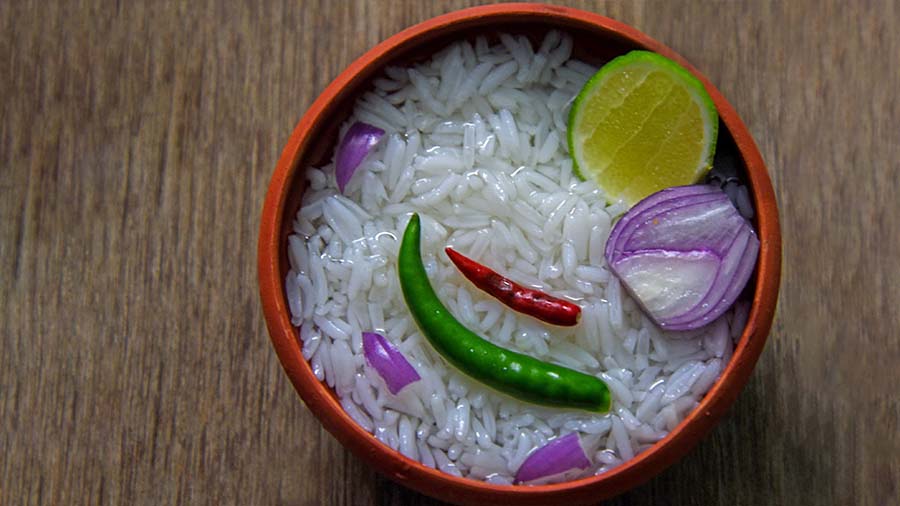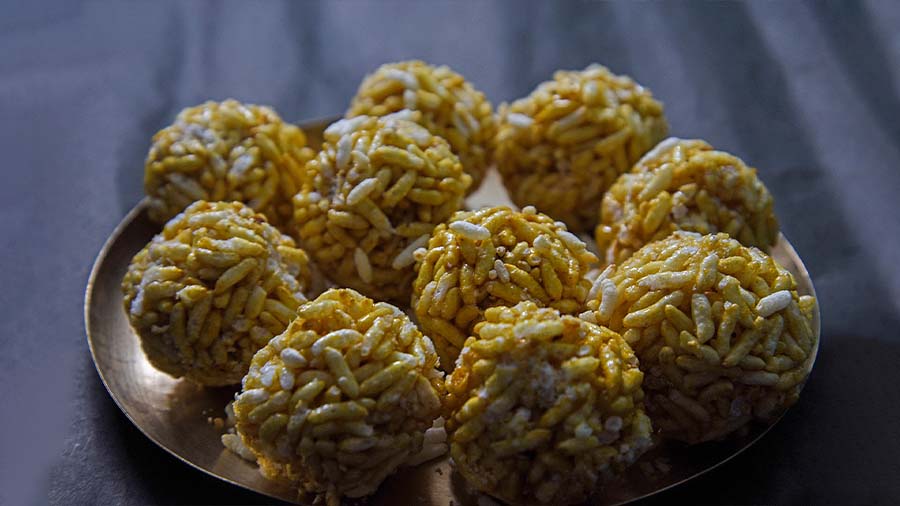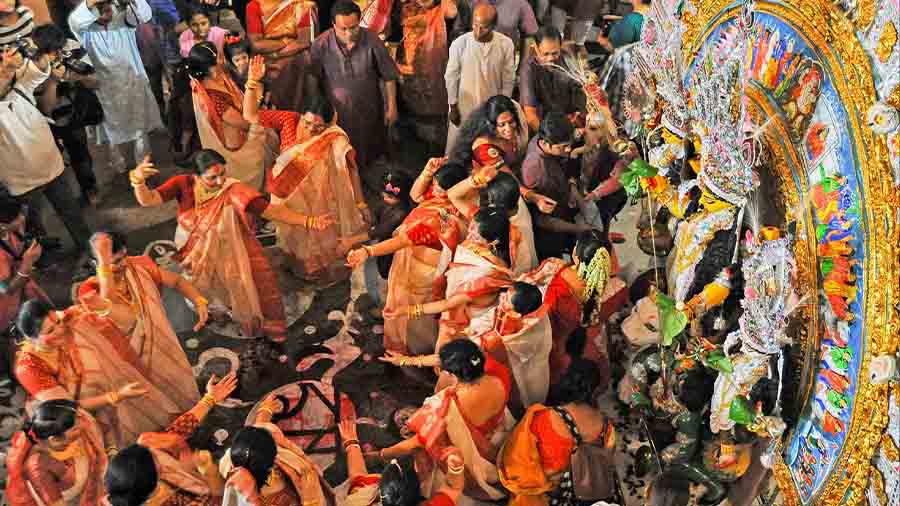On Dashami, which marks the end of Durga Puja, many families observe the tradition of offering sheetal bhog to the goddess. ‘Sheetal’ is a Sanskrit word. It is derived from the root word ‘sheet’, which means cold. Sheetal bhog refers to the cold food that is offered to the goddess. The descendants of Sabarna Roy Choudhury have been celebrating their famed ‘Aatchala Bari’ (eight-roofed structure) Durga Puja at Barisha in Calcutta since 1610. The family members have continued the tradition of offering sheetal bhog to the goddess on Dashami since the inception of this puja, which is considered to be the oldest Durga Puja in the city. The food, which is cooked a day in advance, consists of panta bhaat, khesari dal (a type of lentil known as grass pea), kochu shaak (the stalks of colocasia leaves), koi maachher jhal (climbing perch cooked in spicy gravy) and chaltar ambole (a sweet and sour runny chutney made with elephant apple).

Sheetal blog offered to the Goddess on Dashami morning. belurmath.org
Durga Puja celebrates the victory of Goddess Durga over the demon Mahishasur in a fierce battle that was fought between them, thereby, epitomizing the victory of good over evil. But, in Bengal, this festival also celebrates the goddess’s visit to her natal home with her children, Lakshmi, Saraswati, Ganesh and Kartik—all major deities of the Hindus. The festive season is heralded by the abundant growth of kash phul (a white and feather-like long, oversized grass native to the Indian subcontinent) in the countryside. The festival is preceded by Mahalaya, which is believed to mark the start of Goddess Durga’s journey to her natal home from her husband’s abode in Mount Kailash. It is on this day that the whole of Bengal has been waking up at 4 a.m. since 1932 to listen to Birendra Krishna Bhadra’s recitation of the Chandi Path that is broadcasted by the Calcutta chapter of Akashvani (All India Radio).
Dashami happens to be the day when the goddess, along with her children, is immersed in the river as a symbolic departure from her natal home, bringing the four-day festivities to an end. She is now returning to her husband, Lord Shiva, in Mount Kailash. Sabarna Roy Choudhury’s descendants, like the rest who observe the tradition of offering sheetal bhog to the goddess on this day, believe that the prospect of leaving her natal home makes the goddess sad and she has no appetite to eat. The members of the family are also sad that the goddess is leaving them and are not in a mood to cook on the last day. This explains the reason for the cold and plain fare that is offered to the goddess. Others believe that since the goddess is in such a hurry to return to her husband, there is no time to cook a fresh meal.
Another equally popular preparation in the villages and urban households of Bengal is phana bhaat (literally meaning starchy cooked rice). Phana bhaat is a Bengali rice gruel or porridge preparation. When the starchy rice water (phan) is not drained and eaten with the hot cooked rice, the preparation is called phana bhaat. Salt is always added to the rice while it is being cooked. Although, traditionally, some ghee is spread over the starchy cooked rice, many may add butter to it instead. Like all of the other gruel preparations in the world, phana bhaat is a staple dish for the farming community of Bengal. Since this mushy and starchy rice preparation, which is very filling, is eaten hot, it is prepared more often during winters. It is eaten with all of those preparations that accompany panta bhaat except fritters and boras. Another much liked accompaniment to phana bhaat is a seasoned mash of boiled potato and egg, known as alu deem sheddho makha.

Panta bhaat is a staple Dashami dish in many households in Bengal.
Chitrita Banerji also writes about the abundance of the rice crop leading to other mutations like muri (puffed rice), khoi (popped rice) and chire (beaten rice). All these three forms of rice are enjoyed with equal fervour by the Bengalis. ‘Puffed rice, muri, became a favourite occasional snack as well as breakfast food served with milk and brown sugar. Popped rice, khoi, apart from being eaten with milk, is used to make a favourite winter sweet, moa. It also has a distinctly auspicious significance, unlike puffed rice, for it is poured into the sacred fire in front of which the Hindu wedding takes place, as a special offering to the gods,’ writes Banerji (pp. 54–55).

Moa Amit Datta
But the most interesting mutation is chire. ‘Probably no other region does as much with the chira as Bengal does,’ continues the food historian. ‘Soaked in water and softened, it is eaten with sugar, fruits, yoghurt or milk as phalahar. Combined with the coastal bounty of finely-ground coconut, it provides the most delicate of tastes. It can be fried very quickly in hot ghee or roasted in a dry pot, to be eaten as a savoury item seasoned with salt, pepper and chopped ginger. In winter it is combined with vegetables to make a quick pulao, or with sticky-sweet date-palm sugar to make another kind of moa. Mixed with yoghurt and milk-based sweets, the chira becomes part of the offering for the gods, and brides and bridegrooms go through the ceremony of “dadhimangal” very early on their wedding day when they are given this to eat before the day’s fast begins’.
The text has been excerpted from A Taste of Time: A Food History of Calcutta by Mohona Kanjilal, published by Speaking Tiger Books, April 2021.
